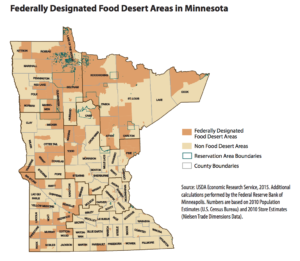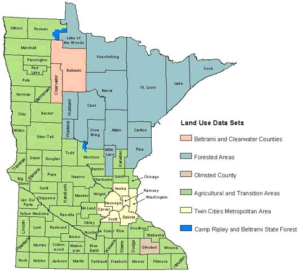The Minnesota Environmental Partnership is proud to feature the following post as part of our Student Voices Series. This is part of a continuing collaboration with Macalester College’s Geography Department and its students. The following column was contributed by Sarah Wescott and represents her views.
One point six million people, or almost one third of Minnesota’s population, do not have easy access to a grocery store. In urban spaces, food deserts are usually found in low income areas, where community members don’t have access to a vehicle and fast food industries target poor populations. However, in rural areas of the state where communities are based around agriculture, food deserts are also in abundance. In the Red River Valley, one of the most fertile areas of the United States, there are more than ten Minnesota counties with food deserts.
Growing up on an apple orchard in Wabasha County, I was surrounded by farmland, and agriculture was the basis of my community. Despite this, the majority of food eaten in my area comes from out of state, and most people drive more than twenty miles to Rochester where there is a larger selection of fresh foods.
The Farm Bill, a comprehensive food and agriculture policy that will expire this coming September, is one of the most important pieces of agricultural legislation in the United States. As most people know, it supports commodity crop production, but it also attempts to address food security issues. We don’t eat most of the corn, wheat, and soy crops that are supported by the bill, yet these crops account for 19 million of the 25 million acres of agricultural land in Minnesota. Most of them end up feeding cows or being converted into biofuels. Therefore, widespread commodity crop production does not help feed more people, instead it contributes to the problem of food insecurity in places like Minnesota.
Every five years, the United States Congress reworks the bill. Ironically, nutrition currently absorbs 79.9% of the $489 billion dollar budget. This focuses on Supplemental Nutrition Assistance Program (SNAP), a project that provides financial assistance to families who cannot afford healthy food, along with an emergency food assistance program. However, the bill does nothing to address the distance that many people must travel to reach a grocery store with healthy options.
The remaining portions of the bill promote an agricultural system that does not produce healthy food for all. Crop insurances and conservation take about 14% of the budget. Meanwhile, commodities and disaster support, which is what many people associate with the bill, receives the remaining five percent. The resulting legislation spans a wide range of issues and affects everyone in the country. Regardless of geography, income, race, or gender every american has a stake in the Farm Bill.
However, the bill fails people on all fronts. While it does work to provide financial assistance to those who can’t afford food, it does not question why people can’t afford food, and where food is inaccessible. Therefore, local food systems are neglected and more time is spent on national output, rather than targeted and thought out food production. Farmers don’t grow other crops because they don’t guarantee profit, SNAP recipients don’t always have access to healthy foods, and most food travels far and wide before it is eaten. This leads to an agricultural system that favors heavily processed crops with little nutritional value and does not sufficiently serve Americans.
In addition, the bill does little to encourage organic production or alternative farming methods, meaning farmers receive minimal support if they want to transition to a cleaner form of agriculture. Moreover, there is no guarantee that farmers have access to healthy foods, leading to food deserts in areas of Minnesota where agriculture is the number one industry. Therefore, the bill is fighting food insecurity on one end and fueling it from the other.
Big money feeds the problem, as large companies like Kraft, Monsanto, and Tyson who benefit from commodity crop production are able to influence agricultural policy in their favor. This year Congress is once again reworking the five year budget for the Farm Bill. We need to ensure that the people’s needs speak louder than the large influential corporations. People need to be aware of the role this bill plays in the life of millions of Americans.
What can you do to help? First, you can tell Tim Walz, Collin Peterson, and Rick Nolan, members of Minnesota’s Agricultural Committee, that you want changes made to the Farm Bill in 2018. Tell Minnesota’s representatives that you want to see investment in local food systems. The Farm Bill should encourage crops that support food security, not commodity crops. This could look like more money for organic research, more subsidies for non commodity crops, and investment in rural development.
Secure food access is a right, not a privilege. Every individual deserves equal access to food. The Farm Bill fails to make this right a reality. Call your representative today!


Food security is an issue dear to my heart. I was raised on a farm and for 18 years when I was a young woman raised and marketed vegetables and fruit (not a large operation but 3 1/2 acres under cultivation is a lot for a woman with young children). I have since “kept my hand in” as volunteer etc. for the extension service etc. I am so glad that we are giving more recognition access to fresh foods, but there is still much to be done. The Dept. of Agriculture needs to put more emphasis on the systems and farmers that are actually providing food to people (near them). the rules that make it possible to use SNAP and WIC coupons ae examples of small steps that are helpful; But more creative solutions; and changing their minset that bigger is better so that help and encouragement are given to small organic farmers (who are usually willing to find ways to get their products into the food desserts near them). So in crafting the Farm Bill bear in mind that the big goal of agriculture is to feed people.